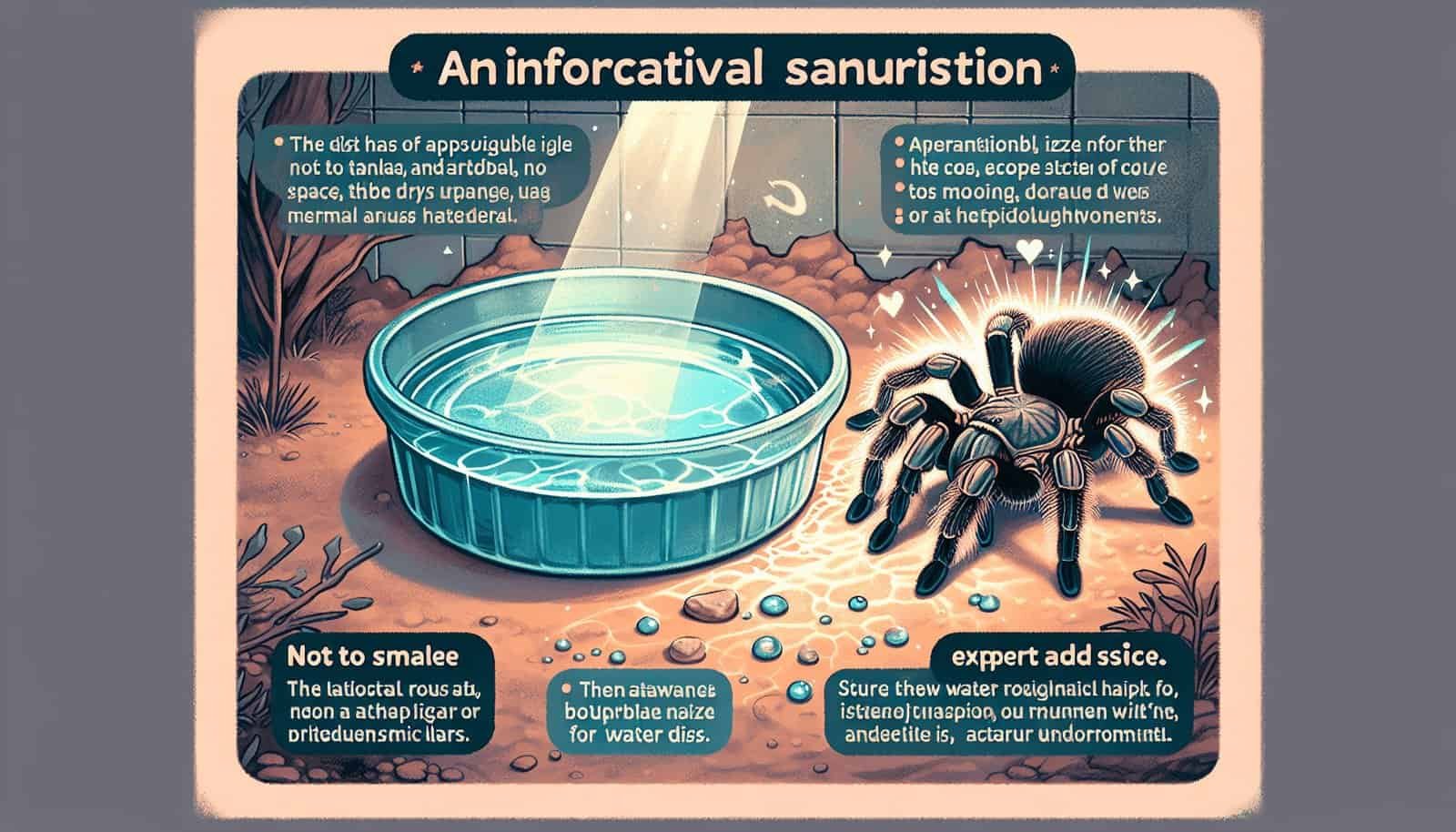Have you ever wondered about the ideal size for a tarantula’s water dish? As a tarantula owner, it is important to provide your arachnid friend with the proper care and environment to thrive. One aspect that often gets overlooked is the size of their water dish. In this article, we will explore the importance of choosing the right water dish size for your tarantula and its impact on their overall health and well-being. So let’s jump right into it and uncover the secrets behind selecting the appropriate size for your tarantula’s water dish.
Importance of a Water Dish for Tarantulas
Having a water dish for your tarantula is essential to ensuring its health and well-being. Tarantulas, like all living creatures, need water to survive. While tarantulas can obtain moisture from their prey, providing them with access to a water dish is important for maintaining hydration. Additionally, a water dish can help create a suitable environment within the tarantula’s terrarium, promoting proper humidity levels and overall comfort.
Tarantulas’ Need for Water
Tarantulas, despite their intimidating appearance, require water for survival, just like any other living organism. While they primarily obtain moisture by preying on insects and other small creatures, having a water dish readily available is crucial. In their natural habitats, tarantulas often encounter water sources such as puddles or moist areas. Therefore, replicating these conditions in captivity through the use of a water dish is essential in meeting their hydration needs.
Benefits of Having a Water Dish
Having a water dish in your tarantula’s terrarium offers numerous benefits. Firstly, it ensures that your tarantula has access to water whenever it needs it. This is particularly important if you are not always available to closely monitor their water consumption. Additionally, a water dish can contribute to the overall humidity level within the enclosure. Tarantulas, depending on their species, have different humidity requirements, and a water dish helps regulate and maintain the appropriate levels.
Choosing the Right Size for the Dish
Selecting the appropriate size for your tarantula’s water dish is crucial for its comfort and convenience. Several factors should be considered when determining the size, including the tarantula species, size and growth, frequency of watering, and the overall size of the terrarium.
Tarantula Species
Different tarantula species have varying water consumption needs and preferences. Some species may require more water than others, while certain tarantulas may be more particular about the cleanliness of their water source. Researching your tarantula’s specific species will help you better understand their water requirements and guide you in choosing an appropriate-sized water dish.
Tarantula Size and Growth
The size of your tarantula plays a significant role in determining the size of the water dish. Smaller tarantulas may not need as large of a dish as larger tarantulas. Additionally, considering the growth potential of your tarantula is essential. It is best to choose a water dish that will accommodate your tarantula as it grows, saving you the hassle of having to upgrade the dish in the future.
Frequency of Watering
Pay attention to how often you need to water your tarantula. If you find yourself regularly refilling the dish, it may be an indication that the current size is insufficient for your tarantula’s needs. On the other hand, if you notice that the water in the dish remains largely untouched, it may be an indicator that the dish is too large. Observing your tarantula’s watering habits can help guide you in choosing the right size.
Terrarium Size
Consider the overall size of your tarantula’s terrarium when selecting a water dish. It is essential to maintain a balanced aesthetic and ensure that there is ample space for the dish without crowding or obstructing your tarantula. Taking into account the available floor space and the height of the enclosure will help you determine the appropriate size and shape of the water dish.
Determining the Appropriate Size
Determining the appropriate size for your tarantula’s water dish can be done through a combination of observing water consumption, researching ideal conditions, and seeking advice from experts or breeders.
Observing Water Consumption
By closely monitoring your tarantula’s watering habits, you can gain valuable insights into its water needs. If you notice that your tarantula consistently finishes the water in its current dish within a short period, it may be an indication that a larger dish is necessary. Conversely, if the water remains untouched for an extended period, it suggests that a smaller dish may be appropriate.
Researching Ideal Conditions
Researching the ideal water requirements for your tarantula’s specific species is essential. By understanding the natural habitat and behavior of your tarantula, you can gain insights into their water needs. Online forums, tarantula care guides, and reputable websites dedicated to tarantula care can provide valuable information on the ideal water conditions for your specific tarantula species.
Contacting Experts or Breeders
If you are still unsure about the appropriate size for your tarantula’s water dish, it never hurts to reach out to experts or breeders in the field. They have firsthand experience and knowledge of tarantula care and can offer guidance on selecting the right dish size. Their expertise and advice can ensure the optimal well-being of your tarantula.
Size Recommendations
While the appropriate size for a tarantula’s water dish may vary depending on the specific circumstances, following these general guidelines can help you make an informed decision.
General Rule of Thumb
As a general rule of thumb, the water dish should be large enough for your tarantula to comfortably access and drink from but not too large to create a drowning risk or take up excessive space in the terrarium.
Small to Medium-Sized Tarantulas
For small to medium-sized tarantulas, a water dish with a diameter of approximately two to three inches often suffices. This allows your tarantula to have ample space to drink and access the water source without risk of drowning. Ensure the dish is shallow enough to prevent your tarantula from submerging itself.

Large Tarantulas
As the size of your tarantula increases, so should the size of the water dish. A dish with a diameter of four to six inches may be more suitable for larger tarantulas. However, always monitor consumption and behavior to ensure the size is appropriate.
Slings or Spiderlings
For tarantula slings or spiderlings, it is crucial to provide a water dish that is proportionate to their size. A shallow bottle cap or small dish can suffice. Remember to adjust the dish size as the tarantula grows.
Choosing the Right Shape and Depth
In addition to choosing the appropriate size, selecting the right shape and depth for the water dish is equally important.
Wide and Shallow Dishes
It is generally recommended to use wide and shallow dishes for tarantulas. This ensures that they can easily access the water source without the risk of drowning. A shallow dish also prevents your tarantula from accidentally submerging itself, ensuring its safety.
Avoiding Deep Water Dishes
Deep water dishes should be avoided as they can pose a drowning risk to your tarantula. Tarantulas are not built for swimming and can easily become overwhelmed by deep water. A shallow dish is always the safer option.

Providing Access Points
To make it easier for your tarantula to access the water dish, consider adding some natural objects such as rocks or small branches as access points. These will enable your tarantula to approach the water dish safely and without difficulty.
Avoiding Drowning Risks
Always prioritize the safety of your tarantula when choosing a water dish. Avoid any sharp edges or materials that may potentially harm your tarantula. Additionally, never fill the water dish to the brim, as this can also increase the risk of drowning. A shallow amount of water is sufficient for your tarantula’s needs.
Water Dish Placement
Proper placement of the water dish within the terrarium is crucial for the well-being of your tarantula.
Distance from Hiding Spots
Place the water dish at a reasonable distance from your tarantula’s hiding spots. This ensures that your tarantula can easily access the water without being exposed or feeling vulnerable.
Temperature and Humidity Considerations
Tarantulas have specific temperature and humidity requirements. Keep the water dish away from any heat sources to prevent evaporation and potential contamination. Additionally, ensure that the dish does not directly affect the temperature or humidity levels within the terrarium, as this may disrupt your tarantula’s comfort.
Avoiding Contamination
To prevent contamination, it is crucial to keep the water dish away from areas where your tarantula may defecate or dispose of uneaten prey. Regularly clean the dish and replace the water to maintain cleanliness and prevent the growth of bacteria or parasites.
Maintaining the Water Dish
Regular maintenance of the water dish is essential for your tarantula’s health and well-being.
Regular Cleaning
A dirty water dish can become a breeding ground for bacteria and parasites, posing a risk to your tarantula. Regularly clean the dish, removing any debris or uneaten prey. Use warm water and a mild soap, ensuring thorough rinsing to remove any soap residue.
Avoiding Chemicals and Residues
Avoid using any chemicals or cleaning solutions in the water dish, as they can be harmful to your tarantula. Stick to warm water and mild soap for cleaning purposes. Ensure that the dish is thoroughly rinsed before refilling to avoid any residue that may harm your tarantula.
Refilling and Replenishing
Check the water dish regularly and refill it as needed. Ensure that the water is fresh and free from any impurities. Avoid overfilling the dish to prevent any accidental spills or saturation of the enclosure substrate.
Signs of Inadequate Water Dish
It is important to be aware of the signs that your tarantula’s water dish may be inadequate.
Dehydration Symptoms
If your tarantula is experiencing dehydration, you may notice symptoms such as a shriveled or wrinkled abdomen, decreased appetite, lethargy, or increased time spent near the water dish. These signs indicate that your tarantula requires more accessible water.
Change in Behavior or Appearance
A change in behavior or appearance, such as increased aggression, excessive hiding, or a duller appearance, may indicate that your tarantula is not receiving enough water. It is essential to monitor your tarantula closely and take appropriate action if any concerning changes occur.
Shedding Issues
Tarantulas require proper hydration to undergo successful molting. If your tarantula is experiencing difficulty shedding its exoskeleton or displays incomplete molting, it may be a sign of inadequate hydration. Ensuring a proper water dish and maintaining appropriate humidity levels will benefit the molting process.
Conclusion
Providing your tarantula with a suitable water dish is crucial for its overall health and well-being. By considering factors such as tarantula species, size and growth, frequency of watering, and terrarium size, you can determine the appropriate size for the dish. Choosing the right shape and depth, placing the water dish correctly, and maintaining it regularly will further contribute to your tarantula’s comfort and hydration. Monitoring your tarantula’s behavior and appearance will help you identify any potential issues and adjust as needed. By prioritizing your tarantula’s water needs, you can ensure its continued health and enjoyment in its habitat.



